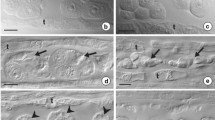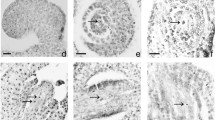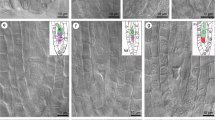Abstract
Amygdalus nana L. (Dwarf Russian Almond) a well-known ornamental plant is endangered in its natural habitats on the territory of Slovakia. Using methods of cytology and embryology, the stages of reproductive cycle of the species were clarified. Especially the development of the male and female reproductive organs, processes of the fertilization and formation of the embryo were studied. The reduction of reproductive potential was caused by synergic influence of negative biotic and abiotic factors. Despite the presence of degenerated, misshapen pollen grains and a great variability in shape and size, a sufficient amount of normally developed viable pollen grains originated within the species Amygdalus nana. We did not observe serious disturbances during megasporogenesis and megagametogenesis, the reduction in fruit set was caused by the degeneration of ovules after unsuccessful pollination (unfavourable conditions during the flowering period) and after unsuccessful seed development, caused mainly by damages of reproductive organs by pests.
Similar content being viewed by others
References
Alburquerque N., Burgos L. & Egea J. 2002. Variability in the developmental stage of apricot ovules at anthesis and its relationship with fruit set. Ann. Appl. Biol. 141: 147–152.
Burgos L., Berenguer T. & Egea J. 1993. Self and cross compatibility among apricot cultivars. Hort. Sci. 28: 148–150.
Cerović R. & Mićić N. 1999. Functionality of embryo sacs as related to their viability and fertilization success in sour cherry. Sci. Horticult. 79: 227–235.
Cousin M. & Maataoui M.E. 1998. Female reproductive organs in self-compatible almond (Prunus dulcis) ‘Lauranne’ and fertilization patterns. Sci. Horticult. 72: 287–297.
Čeřovský J., Feráková V., Holub J. Maglocky Š.& Procházka F. (eds) 1999. Červená kniha ohrozenych a vzácnych druhov rastlín a živočíchov SR a ČR 5. Vyššie rastliny, Príroda, Bratislava, 456 pp.
Davis G.L. 1966. Systematic Embryology of the Angiosperms, John Wiley and Sons, New York, 528 pp.
Egea J. & Burgos L. 1994. Year to year variation in the developmental stage of the embryo sac at anthesis in flowers of apricot (Prunus armeniaca L.). J. Horticult. Sci. 69: 315–318.
Egea J. & Burgos L. 2000. Ovule differences between singlekernelled and double-kernelled fruits in almond (Prunus dulcis). Ann. Appl. Biol. 136: 291–295.
Erdelská O. 1986. Embryo development in the dogwood Cornus mas. Phytomorphology 36: 23–28.
Erdelská O. & Kuna R. 1995. A renewed interest in biology of Ephedra. Biologické listy 60(2): 127–131.
Feráková V., Maglocky Š. & Marhold K. 2001. Červený zoznam papraďorastov a semennych rastlín Slovenska. Ochrana Prírody, Banská Bystrica, 20(Suppl.): 48–81.
Furukawa Y. & Bukovać M.J. 1989. Embryo sac development in sour cherry during the pollination period as related to fruit set. Horticult. Sci. 24: 1005–1008.
Jakovlev M.A. 1985. Sraviteľnaja embryologija cvetkovych rastenij, Nauka, Leningrad, 133 pp.
Johri B.M., Ambegaokar K.B. & Srivastava P. S.1992. Comparative Embryology of Angiosperms, Springer Verlag, Berlin Heidelberg, 1221 pp.
Keserović Z. 1996. Embriogeneza u trešnje i višnje. Jugoslovensko voćarstvo 30: 143–150.
Király G. (ed.) 2007. Vörös Lista. A magyarországi edényes flóra veszélyeztetett fajai, Saját kiadás, Sopron, 73 pp.
Miaja M.L., Radicati L., Porporato M., Caramiello R., Fossa V. & Vallania R. 2000. Morpho-physiological observations on pollen of sour cherry (Prunus cerasus L.) cultivars. Acta Horticult. 514: 311–320.
Mikatadze-Pantsulaya T.A. 1985. A study of the development of the female generative sphere of some species of Amygdalus L.. Soobscheniya Akademii Nauk Gruzinskoi SSR 117: 577–580.
Oukabli A., Wallali D.L., Lansari A., Abousalim A. & Egea J. 2001. Embryo sac development and fertilization aspects in the self-compatible almond (Prunus dulcis (Mill.) D.A. Webb cv. “Tuono”. Fruits 56: 93–99.
Oukabli A., Lansari A., Wallali D.L., Abousalim A., Egea J. & Michaux-Ferriére N. 2002. Self and cross pollination effects on pollen tube growth and fertilization in self-compatible almond Prunus dulcis cv. “Tuono”. J. Hortic. Sci. Biotech. 75: 739–744.
Pazourková Z. 1982. Botanická mikrotechnika, Ed. KU, Praha, 166 pp.
Pimienta E. & Polito V.S. 1982. Ovule abortion in ‘Nonpareil’ almond [Prunus dulcis (Mill) D.A. Webb]. Amer. J. Bot. 69: 913–920.
Pimienta E. & Polito V.S. 1983. Embryo sac development in almond [Prunus dulcis (Mill.), D.A.Webb] as affected by cross-, self- and non-pollination. Ann. Bot. 51: 469–479.
Poddubnaya-Arnoldi V.A. 1982. Charakteristika semjejstv pokrytosemennych rastenij po citoembryologičeskim priznakam, Nauka, Moskva, 115 pp.
Schauz R. & Stösser R. 1992. Die Entwicklung des Endosperms und Embryos bei Prunusarten in Beziehung zum Fruchtansatz. Gartenbauwissenschaft 57: 228–234.
Stösser R. & Anvari S.F. 1982. On the senescence of ovules in cherries. Sci. Horticult. 16: 29–38.
Svobodová Z. & Ulrych L. 2000. S’učasný stav rastlinného krytu prírodnej rezervácie Vŕšok. Rosalia 15: 7–14.
Šurbanovski N., Tobutt K.R., Konstantinović M., Maksimović V., Sargent D.J., Stevanović V., Ortega E. & Bošković R.I. 2007. Self-incompatibility of Prunus tenella and evidence that reproductively isolated species of Prunus have different SFB alleles coupled with an identical S-RNase allele. Plant J. 50: 723–734.
Talaie A.R., Imani A., Ferguson L. & Kester D. 1998. Morphology of pollen grains as an index for identification of local Iranian almond varieties. Acta Horticult. (ISHS) 470: 280–285.
Thompson M.M. & Liu L.J. 1973. Temperature, fruit set, and embryo sac development in ‘Italian’ prune. J. Amer. Soc. Horticult. Sci. 98: 193–197.
Author information
Authors and Affiliations
Corresponding author
Rights and permissions
About this article
Cite this article
Chudíková, R., Ďurišová, Ľ., Baranec, T. et al. Cytological and histological studies on male and female gametophyte of endangered species Amygdalus nana in Slovakia. Biologia 66, 783–789 (2011). https://doi.org/10.2478/s11756-011-0085-3
Received:
Accepted:
Published:
Issue Date:
DOI: https://doi.org/10.2478/s11756-011-0085-3




